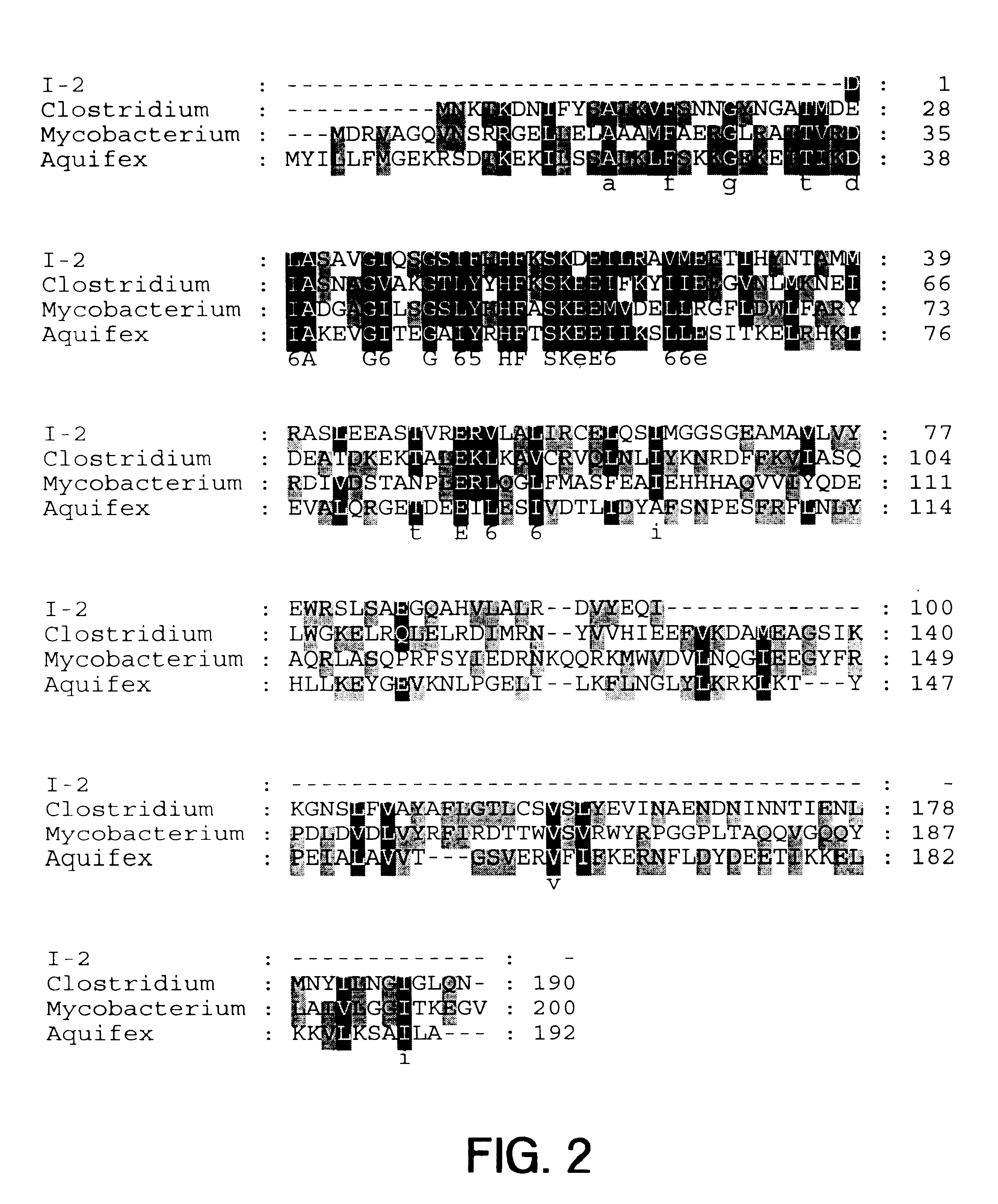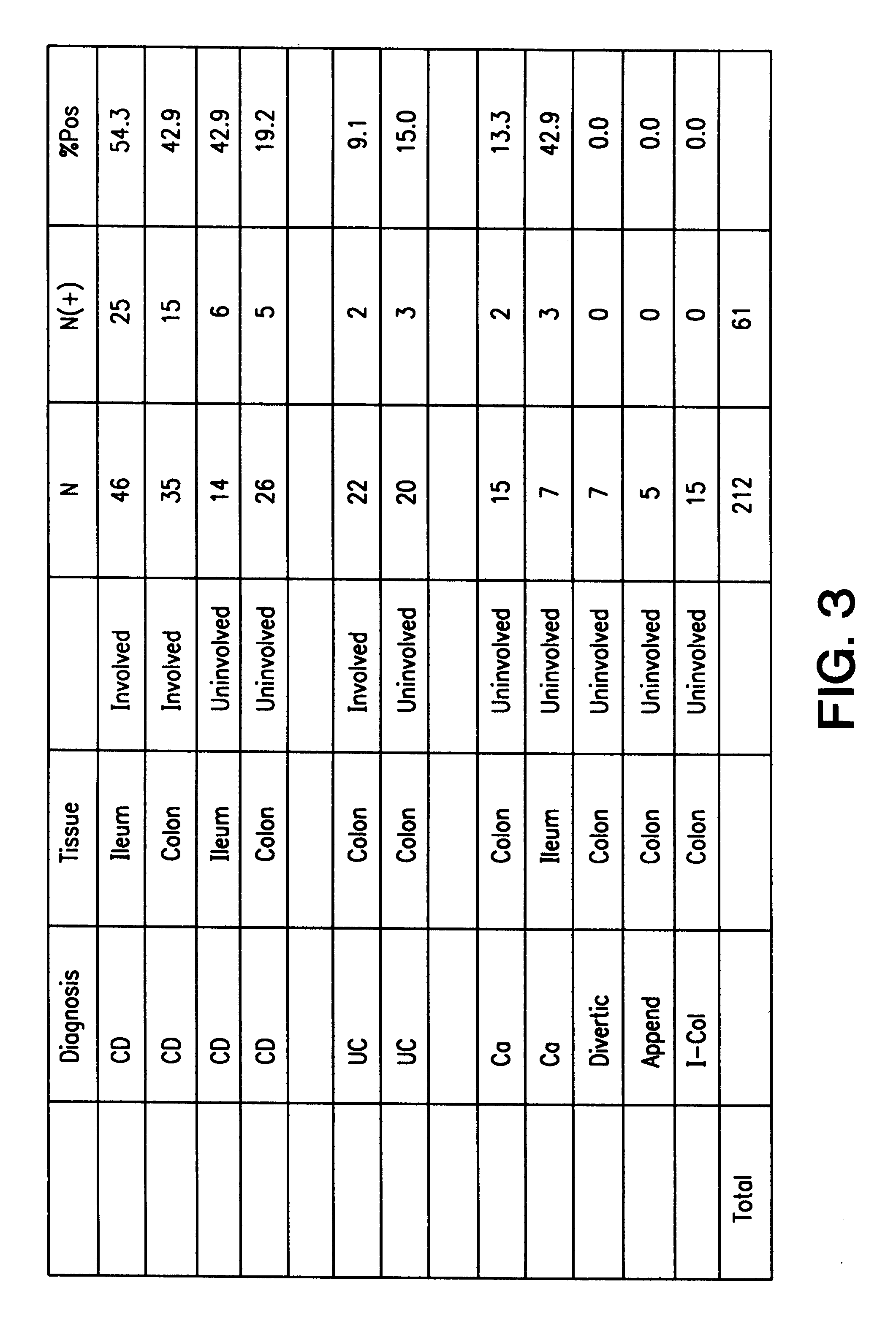IBD-associated microbial antigens and methods of using same
a technology of inflammatory bowel disease and antigens, which is applied in the field of immunology, microbiology and inflammatory bowel disease, can solve the problems of ibd patients being at increased risk for the development of intestinal cancer, fewer available therapies for inflammatory bowel disease, and affecting diagnosis and treatmen
- Summary
- Abstract
- Description
- Claims
- Application Information
AI Technical Summary
Problems solved by technology
Method used
Image
Examples
example ii
Differential Reactivity of IBD Patient and Normal Sera to the I-2 Polypeptide
This example demonstrates that the I-2 polypeptide is differentially reactive with Crohn's disease patient sera as compared to normal sera.
A. GST-I-2 Fusion Protein
The full-length I-2 encoding nucleic acid sequence (SEQ ID NO: 1) was cloned into the GST expression vector pGEX. After expression in E. coli, the protein was purified on a GST column. The purified protein was shown to be of the expected molecular weight by silver staining, and had anti-GST reactivity upon western analysis.
B. ELISA Analysis
ELISA analysis was performed with GST-I-2 (SEQ ID NO: 2) fusion polypeptide using diluted patient or normal serum. Reactivity was determined after subtracting reactivity to GST alone. Varying dilutions of CD sera and sera from normal individuals were assayed for IgG reactivity to the GST-I-2 fusion polypeptide. As shown in FIG. 4A, dilutions of 1:100 to 1:1000 resulted in significantly higher anti-I-2 polypepti...
example iii
Reactivity of CD4+ T cells with the I-2 Polypeptide
This example demonstrates that T cells derived from normal mice proliferate in response to the I-2 antigen (SEQ ID NO: 2).
CD4+ T cells were isolated from normal C57BL / 6J mice, and T cell proliferation assayed in response to the I-2 antigen as follows. To prepare the CD4+ T cells, spleens from 8-10 week old female mice were removed and placed into cell suspension. The cells were depleted for B cells and antigen presenting cells (APCs) using nylon wool and then depleted for CD8+ T cells using anti-CD8 magnetic beads. Flow cytometry was used to determine the purity of the CD4+ T cell suspension.
For preparing APCs, spleens from 8-10 week old females are removed, placed into cell suspension, and pulsed overnight with 0, 2, 10, or 15 .mu.g / ml of the I-2 polypeptide. The APCs are irradiated with 3,000 rads before being added to the T cell cultures. To assay for antigen specific proliferation of T cells, 4.times.10.sup.5 CD4+ T cells / well w...
example iv
Isolation and Identification of the Organism containing the I-2 Sequence
This example describes isolation and identification of the organism containing the I-2 sequence.
Tissue resections from CD patients are obtained from Cedars-Sinai under anaerobic conditions. DNA is extracted from a small piece of tissue using the Qiagen tissue prep kit, and tested for the presence of the I-2 nucleic acid sequence SEQ ID NO: 1 using the PCR assay described above. Cells from positive scoring sections are cultured under a variety of conditions (see FIG. 7), and the isolates catalogued.
After assaying the isolates by PCR for 16S RNA to assure that the target DNA is accessible to amplification, isolates are assayed by PCR for the I-2 nucleic acid sequence (SEQ ID NO: 1) as described in Example I. The 16S RNA of isolates containing the I-2 nucleic acid are sequenced to identify the organism essentially as described in Wilson and Blitchington, Applied and Environ. Microbiol. 62:2273-2278 (1996), which is...
PUM
| Property | Measurement | Unit |
|---|---|---|
| Fraction | aaaaa | aaaaa |
Abstract
Description
Claims
Application Information
 Login to View More
Login to View More - R&D
- Intellectual Property
- Life Sciences
- Materials
- Tech Scout
- Unparalleled Data Quality
- Higher Quality Content
- 60% Fewer Hallucinations
Browse by: Latest US Patents, China's latest patents, Technical Efficacy Thesaurus, Application Domain, Technology Topic, Popular Technical Reports.
© 2025 PatSnap. All rights reserved.Legal|Privacy policy|Modern Slavery Act Transparency Statement|Sitemap|About US| Contact US: help@patsnap.com



